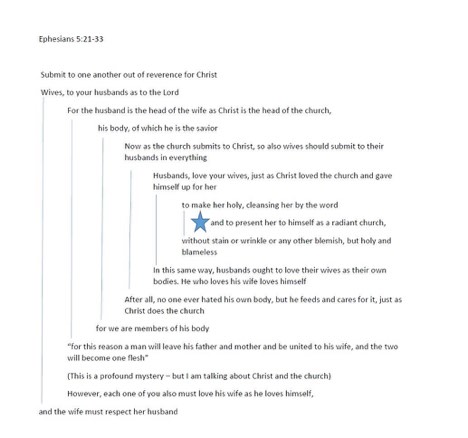If we read the Bible as one story about God’s redemptive plan, it seems that equality and freedom are part of the message that cannot be overlooked. God’s redemptive story is the story of undoing sin and its fruit. Oppression and inequality are the result of broken relationships, and are the fruit of sin. We see it in Genesis 3. The moment sin enters the world the relationship between people and God, man and woman, and people and the earth are all sent into turmoil. Yet through the rest of Scripture we see our relationship with God restored through Jesus Christ, and ultimately, the restoration and redemption of all brokenness when Christ returns.
While the world only knows a taste of that ultimate redemption now, the final chapters of God’s story erase all inequality, all oppression, all sin. The final work of Christ raises all believers up equally before Christ, as heirs.
Does God’s Redemptive Work Apply to Women?
Despite the message of equality that is inherent in God’s redemptive work, many people turn to Paul’s writings in the New Testament and pull out verses and passages to prove that the Bible prescribes a lower place for women than men in the church and home. These verses have been used by men in the Church for centuries to justify male-only leadership. In recent years, many patriarchal groups have softened their language a bit, proclaiming that women are equal to men, they simply have a different calling, one lacking the responsibility of co-authority alongside men. (Leaving one to wonder by what definition women are then truly seen as “equals”!)
Bible scholars have wrestled through the relevant passages, looking at the original language, the use of various Greek words, the historical and cultural context, and have come to different conclusions on how to understand these passages.
A Rule or an Arch?
Ephesians 5:21-33 is frequently used to establish male headship in marriage. Many will point to it to say that the man is the spiritual head of the household, and that a woman should submit to the leadership of her husband as the Church should submit to the leadership of Christ. I find this to be problematic, believing that there is a more faithful way to read this passage, one more in line with the overarching narrative of redemption in Scripture.
Recently, as many have before me, I made the claim that the passage in Ephesians is a passage about unity, and not about a hierarchy of authority.
I have received two different challenges from Christians to this position:
- The passage is absolutely about hierarchal authority, and must be understood and followed as such.
- The passage is absolutely about hierarchal authority, is dangerous and untrustworthy, and therefore must be thrown out.
Both of these challenges assume that the best interpretation of this passage results in a hierarchical understanding of gender roles, and that men are to exercise an ultimate form of headship/leadership over women. The first challenge is mainly concerned with upholding the authority of Scripture. The second challenge takes a lower view of scripture, and although it agrees with the interpretation, opts to simply dismiss it as passé and irrelevant to our time.
Neither of these options will suffice for those of us committed to the authoritative place of Scripture for Christians and to the grand picture of God’s redemptive mission. God does not present us with the options of a trustworthy Bible that dictates patriarchy, or a useful, but not entirely trustworthy Bible. What God presents us with is a story of redemption, that when interpreted as such, is entirely trustworthy, and frees us from patriarchy.
Mental Gymnastics
Does it require mental gymnastics to trust in both the goodness of God, and the trustworthiness of Scripture? I don’t believe so. It only requires proper interpretation that keeps both of these in focus against the larger backdrop of the redemptive story of Scripture.
With that in mind, when we take a more engaged look at the Ephesians passage in question, the passage takes on a very different message than that of hierarchy in marriage.
Margaret Mowczko suggests that the passage has a chiastic structure, a series of parallel statements, with the main message in the center. If you look at the diagram below you can see that the main message of this passage is found in verse 27: Christ will present a radiant church to himself. Does it require mental gymnastics to trust God's goodness and the trustworthiness of Scripture? Click To Tweet
 Signposts
Signposts
If we work backwards from the center, we see an explanation of this mystery. N.T. Wright calls marriage a signpost towards a deeper reality. Paul is using the relationship of marriage to describe what the unity of Christ and the Church (his Bride!) is meant to be like. But, rather than being a passage about marriage and how it should be modeled on Christ’s leadership of the Church, it is instead a passage about what will happen at Jesus’ return, when Christ and the Church become unified. And while marriage may be a signpost pointing to that ultimate reality, it is that reality which our marriages should reflect. Ultimate reality is what our marriages should reflect. Click To Tweet
The first six verses leading up to the crux of the message talk about marriage. The last six verses talk about the body. The first six verses cannot be understood without being read in light of the last six verses. And the most important imagery is that of one flesh.
Paul quotes the passage in Genesis 2:24, “for this reason a man will leave his father and mother and be united to his wife, and the two will become one flesh.” This is immediately preceded in Genesis by 2:23 which states, “the man said, ‘This is now bone of my bones and flesh of my flesh; she shall be called ‘woman,’ for she was taken out of man.’” The mystery of the unity of marriage stems from the fact that man and woman are made of the same substance. They are the same flesh and bone. And for that reason, they shall join together in a union that joins them like one body. In fact, the man and woman together have the ability to literally produce a new flesh and bone body.
Using the same body imagery, Paul talks about the head and the body being one. The head is nothing without the body, and the body is nothing without the head. He states that the husband is head of the body as Christ is the head of the church, but there is no reason to believe he is talking about head in the sense of hierarchical leadership, when all of the imagery in the passage points to head in a literal sense. A husband must love his wife as he loves his own body, because they are of the same body. They are one flesh. And in the same way that they are one, all believers will one day be united with Christ as one. It’s a great mystery, Paul writes, the mystery of Christ and the Church.
Verse 21 serves as a heading for the following verses. Paul says wives submit to their husbands, but we are all supposed to submit to one another. And although wives submitting to husbands was culturally expected in Paul’s day, Paul reminds us that, rather than a hierarchy, marriage is a unity. It is not that the husband is the leader and the wife is the follower, it is that they are one body. Marriage is a one-flesh unity, and a husband must love his wife as his own body. Functionally, then, as one body, the husband and wife submit to each other, as verse 21 states. Functionally, then, as one body, the husband and wife submit to each other. Click To Tweet
We must keep the redemption story in mind while working through difficult passages. Without an inclination to removing the distinctiveness of our gendered identities, God is nevertheless working to undo inequality of every kind. Inequality is a result of the brokenness of sin, and never something to be embraced. The final unification of Christ and the church will complete the redemption work in, not only the church, but all of creation. I believe our trustworthy God has given us a trustworthy Bible, and it’s our calling to trust it, and to do our best to interpret it in light of God’s redemption plan.







Missio Alliance Comment Policy
The Missio Alliance Writing Collectives exist as a ministry of writing to resource theological practitioners for mission. From our Leading Voices to our regular Writing Team and those invited to publish with us as Community Voices, we are creating a space for thoughtful engagement of critical issues and questions facing the North American Church in God’s mission. This sort of thoughtful engagement is something that we seek to engender not only in our publishing, but in conversations that unfold as a result in the comment section of our articles.
Unfortunately, because of the relational distance introduced by online communication, “thoughtful engagement” and “comment sections” seldom go hand in hand. At the same time, censorship of comments by those who disagree with points made by authors, whose anger or limited perspective taints their words, or who simply feel the need to express their own opinion on a topic without any meaningful engagement with the article or comment in question can mask an important window into the true state of Christian discourse. As such, Missio Alliance sets forth the following suggestions for those who wish to engage in conversation around our writing:
1. Seek to understand the author’s intent.
If you disagree with something the an author said, consider framing your response as, “I hear you as saying _________. Am I understanding you correctly? If so, here’s why I disagree. _____________.
2. Seek to make your own voice heard.
We deeply desire and value the voice and perspective of our readers. However you may react to an article we publish or a fellow commenter, we encourage you to set forth that reaction is the most constructive way possible. Use your voice and perspective to move conversation forward rather than shut it down.
3. Share your story.
One of our favorite tenants is that “an enemy is someone whose story we haven’t heard.” Very often disagreements and rants are the result of people talking past rather than to one another. Everyone’s perspective is intimately bound up with their own stories – their contexts and experiences. We encourage you to couch your comments in whatever aspect of your own story might help others understand where you are coming from.
In view of those suggestions for shaping conversation on our site and in an effort to curate a hospitable space of open conversation, Missio Alliance may delete comments and/or ban users who show no regard for constructive engagement, especially those whose comments are easily construed as trolling, threatening, or abusive.